 As specialty drugs continue to earn a greater share of the pharmaceutical market, marketing, sales, and key opinion leader (KOL) professionals are faced with addressing market access issues, while needing to create an attractive value proposition for physicians. Going forward, these roles will expand to include responsibilities related to education, reimbursement knowledge, and services that support patients, payers, as well as physicians.
As specialty drugs continue to earn a greater share of the pharmaceutical market, marketing, sales, and key opinion leader (KOL) professionals are faced with addressing market access issues, while needing to create an attractive value proposition for physicians. Going forward, these roles will expand to include responsibilities related to education, reimbursement knowledge, and services that support patients, payers, as well as physicians.
Case in point, in a presentation given earlier this year at eyeforpharma 2016, Deborah Waterhouse, senior VP and business unit head, U.S. primary care, GSK spoke on how her company has made radical changes to its sales incentives and relationships with KOLs to move patient well-being to the forefront.
According to Ms. Waterhouse, speaking at the conference, sales reps at GSK are paid to educate physicians, and top performers also earn bonuses. Top performers are rated on their scientific knowledge and the quality of their physician calls, instead of any prescription lift.
“We’ve gone from an incentive system that was super complex and very empirical to a much more customer- and patient-orientated system that is simple to understand and based on the quality of the dialogue sales reps have with customers," Ms. Waterhouse says.
On the KOL level, GSK has also stopped reimbursing physicians to speak on behalf of its products. The company reports that not paying KOLs has not caused any loss of volume or quality in physician discussions.
Ms. Waterhouse noted that their results show that interactions between physicians are just as impactful when a physician is not being paid as when GSK was providing payments.
These changes are all part of a new operational model focused on putting the patient at the heart of its business strategy, and although some steps seemed risky at first, Ms. Waterhouse says these moves have not negatively affected the bottom line, as one might expect, and have actually increased sales.
“Truly being connected to the customer will build a strong position of trust but can also deliver a strong financial performance which will keep shareholders happy," she says.
According to Robert Groebel, VP of global medical strategy at Veeva Systems, there are four key factors that life-sciences companies need to keep in mind when developing relationships with the specialty physician today — some of which the industry is already doing.
“The first is increased integration around specific therapeutic areas to allow a more integrated engagement model around the patient," he says. “Second, companies should start shifting investments away from traditional marketing initiatives to value-based selling — for example, HEOR data generation — down to specific key accounts."
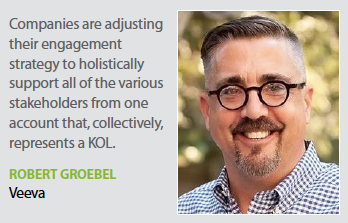 A third element, he says, is to capture enterprise-level customer insights to drive better coordination across medical, market access, and marketing and sales teams. This can only work if cloud-based technologies are used to integrate a variety of data sets continuously and in real time.
A third element, he says, is to capture enterprise-level customer insights to drive better coordination across medical, market access, and marketing and sales teams. This can only work if cloud-based technologies are used to integrate a variety of data sets continuously and in real time.
“Finally, companies should consider new research that shows the tremendous impact of localization of marketing and sales strategies, tailored to local market dynamics," Mr. Goebel says.
In specialty medicines, value is now part of the everyday conversation, and has driven an evolution where market access discussions are part of the language included in a sales call, as well as from the KOL podium, says Amy Graham, general manager, Ogilvy CommonHealth Specialty Marketing, part of Ogilvy CommonHealth Worldwide.
“This new norm includes language on health outcomes, reimbursement, and pathways," Ms. Graham says. “For example, in oncology, the National Comprehensive Cancer Network, an alliance of the world’s leading cancer centers, adopted a value framework and it is common practice to hear a KOL speak to the overall value of a drug. This evolution reinforces the need to have a cohesive brand strategy in place to address these points, and to ensure that we have a message strategy that aligns the right message to the right target."
As companies become increasingly focused on the value of the products they sell, health economic strategies and modeling are no longer just an afterthought or a supporting tactic for other functions.
“Companies now routinely involve health economic functions early in the decision-making process and in the development of the core value proposition," says Herman Sanchez, partner, Trinity Partners. “Developing a value story for the product is now absolutely essential to the success of the product."
Health economics and outcomes research (HEOR) data are a critical component of the value story that commercial and medical teams are sharing with payers, hospital systems, and healthcare providers.
 “As we move into an era of value-based care, clinical trial data alone will no longer be enough to drive commercial success,
“As we move into an era of value-based care, clinical trial data alone will no longer be enough to drive commercial success,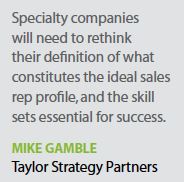 " says Joe DePinto, president, Cardinal Health Specialty Solutions. “Manufacturers will need to invest in developing real-world data sets that demonstrate both the clinical efficacy and economic value of their products using health economics and outcomes research, such as patient reported outcomes studies, comparative effectiveness studies, and budget impact analyses."
" says Joe DePinto, president, Cardinal Health Specialty Solutions. “Manufacturers will need to invest in developing real-world data sets that demonstrate both the clinical efficacy and economic value of their products using health economics and outcomes research, such as patient reported outcomes studies, comparative effectiveness studies, and budget impact analyses."
Although there is never a one-size-fits all approach to best address the needs of the specialty physician, there are several core fundamentals that need to be in place, such as having a solid and cohesive brand strategy that addresses the challenges and opportunities for the brand, and building a plan that executes on that strategy, Ms. Graham says.
“This needs to include an understanding of what the customers’ needs are, and aligning how the brand and its offerings can best service those needs," she says.
Reinventing Specialty Sales
“In today’s environment, it is time for companies to revamp the traditional roles of sales and KOLs to include expertise on reimbursement policies and the ability to facilitate a patient’s care," says Nicole Hebbert, VP, patient access and engagement, United BioSource (UBC). “The net result is that pharma is reevaluating the traditional sales role and focusing instead on specialized roles, such as field-based reimbursement teams and clinical nurse educators."
For example, companies are creating new positions specifically designed to support patients. Many companies have created a reimbursement specialist role along with a nurse educator position to ensure that patients have access and understand the appropriate administration of the specialty product.
“Biopharm companies realize they need to create different field-based roles to effectively promote and ensure that appropriate patients have access to their products," says Curt Staab, VP, emerging life sciences network, TGaS Advisors.
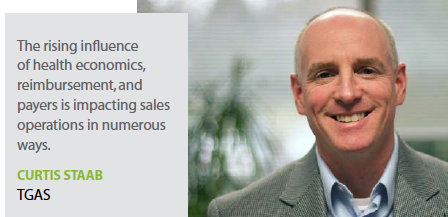 According to Mr. Staab, these new roles require sales operations teams to provide support beyond the traditional specialty representative role. This includes decisions on how to support these less traditional roles, which impact CRM systems and incentive compensation. TGaS benchmark data show that often these new field teams are supported in the same CRM system, but the activity is not visible to the traditional sales representative team. In addition, the incentive compensation plans are typically different, with more of an emphasis on management by objective (MBO) than on actual sales.
According to Mr. Staab, these new roles require sales operations teams to provide support beyond the traditional specialty representative role. This includes decisions on how to support these less traditional roles, which impact CRM systems and incentive compensation. TGaS benchmark data show that often these new field teams are supported in the same CRM system, but the activity is not visible to the traditional sales representative team. In addition, the incentive compensation plans are typically different, with more of an emphasis on management by objective (MBO) than on actual sales.
As more pharma companies identify specialty areas as a primary driver for growth, the demand for representatives with specific therapeutic knowledge is significantly increasing. One key indicator of this trend, according to the TGaS Advisors Annual State of Incentive Compensation Landscape, is that the incentive compensation target payout for these representatives increased 9% between 2015 and 2016.
“While different roles have been created, there is still a need for the traditional specialty sales representative," Mr. Staab says. “However, the rising influence of health economic, reimbursement, and payer influence is impacting sales operations in numerous ways."
For example, specialty companies will need to rethink their definition of what constitutes the ideal sales rep profile, and the skill sets essential for success.
While the answer to solving for the ideal sales candidate will vary from company to company and by therapeutic area, there are some common trends.
“Today, 60% of all HCPs are part of an integrated delivery network (IDN)," says Mike Gamble, VP, business development, Taylor Strategy Partners. “The prescriptions that an HCP can and cannot write are being dictated from the top down. As a result, C-suite skills are now viewed as not only beneficial for sales reps, but often essential and candidates with a strong business-to-business background are highly sought after. Additionally, as digital plays an ever-increasing role in how HCPs consume information, candidates who can synchronize and integrate nonpersonal with personal messages can significantly improve and increase prescribing behavior."
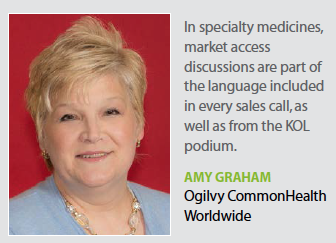 While HCP access overall has continued to decline, the specialty markets typically have even greater restrictions than primary care — although dermatology is just one specialty that defies this trend. As a result, companies are seeking candidates whose profile indicates that they are “hunters," not passive players in the sales process. These individuals are capable of executing the total office call, as so many specialty products depend not only on the physician, but on the clinical nurses, reimbursement specialists, and others.
While HCP access overall has continued to decline, the specialty markets typically have even greater restrictions than primary care — although dermatology is just one specialty that defies this trend. As a result, companies are seeking candidates whose profile indicates that they are “hunters," not passive players in the sales process. These individuals are capable of executing the total office call, as so many specialty products depend not only on the physician, but on the clinical nurses, reimbursement specialists, and others.
As more and more HCPs — 80% of all Medicare doctors — are compensated for patient outcomes versus traditional fee-for-service, pharma companies are also seeking candidates who are critical thinkers. These individuals act on data-driven decision-making, combined with enhanced business acumen.
More sales teams are also shifting to an account-based selling model, allowing them to build relationships with a targeted set of accounts and use hyper-personalized messaging for each account. In today’s market, this model is now a necessity and is starting to replace traditional one-to-one sales in life sciences, Mr. Groebel says.
“Companies are adjusting their engagement strategy to holistically support all of the various stakeholders from one account that, collectively, represents a KOL," he says.
What Physicians Want
Veeva Systems recently surveyed specialty physicians on what drives strong partnerships with life-sciences companies. The No. 1 driver was the availability of relevant information, and companies that provide such information to physicians were named as one of their top three most trusted partners in a given disease area.
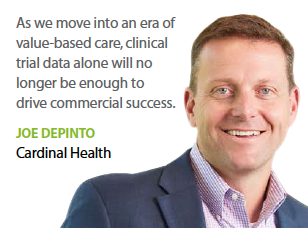 Mr. Sanchez agrees that providing physicians with information is a solid approach to supporting specialty physicians, however, the information must be pertinent to the specialty. In today’s market environment, and especially for orphan-indication patients, the information needs to be highly tailored, personalized, and specific to the individual patient need.
Mr. Sanchez agrees that providing physicians with information is a solid approach to supporting specialty physicians, however, the information must be pertinent to the specialty. In today’s market environment, and especially for orphan-indication patients, the information needs to be highly tailored, personalized, and specific to the individual patient need.
“Not only does that include information related to diagnostic variables, but also patient variables on how physicians can best reach patients, help them through the patient journey, and maintain compliance for these specialty medications," Mr. Sanchez says. “This kind of information supports a high degree of physician engagement, and arms physicians with the tools necessary to provide better care to specialty patients."
According to results of a Sermo physician survey conducted by Publicis Touchpoint Solutions, physicians increasingly want biopharma companies to use a combination of communication channels to deliver the best value for their practices, including higher-quality field sales representatives and a variety of nontraditional representatives. Physicians report they want more customer service representatives, hybrid representatives, and clinical health educators, particularly around specialty products.
To best serve the specialty physician of today, specialty brands must be able to provide solutions to the inherent complexities of market access, whether they are access and reimbursement challenges or medication administration and adherence challenges.
“Pharmaceutical companies need to come to market with appropriate support services, such as patient assistance or reimbursement support and adherence programs to ease these challenges for specialty physicians and make the journey smoother for patients," Mr. DePinto says. “Effective support programs are patient-focused and are designed with deep understanding of the particular issues surrounding the specialty disease."
“Physicians are looking for partners who can problem-solve along with them and help ease the burden of administrative encumbrances that take away from the time needed to truly practice medicine," Ms. Hebbert says. “Teams that can understand competitive markets that affect specific physicians’ practices will gain the trust of providers and provide key services."
It is critical for the success of specialty products to have services available to navigate the complexities involved in the treatment journey. Creating support services to help with reimbursement and financial challenges go a long way in supporting the prescriber and patients with initiation of therapy, says Denise Von Dohren, VP, access solutions, RxCrossroads Specialty Solutions.
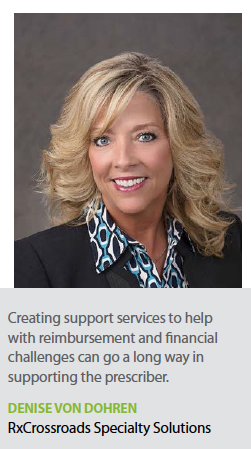 For example, she says coordinating communication between stakeholders — prescribers, patients, and potentially caregivers — ensures patients have the support from a fully informed care team.
For example, she says coordinating communication between stakeholders — prescribers, patients, and potentially caregivers — ensures patients have the support from a fully informed care team.
“The complications associated with access, affordability, and adherence provide an opportunity to manufacturers to provide assistance through customized specialty hub services," she says. “These services include clinical nursing services, financial assistance, reimbursement support and adherence support.
Companies should also consider providing educational tools that allow the prescriber and staff to clearly articulate the ‘what to expect’ from start of therapy through chronic use or therapy completion."
Hub services can be particularly important in easing the burden on providers to manage prior authorizations, denials, and appeals. Hub services can also help with medication adherence and compliance so patients can get the optimal benefit from their therapies.
“A coordinated effort between the manufacturer’s commercial team and the hub is critically important to ensure that access to specialty medicines is streamlined for both providers and patients," Mr. DePinto says.
Ms. Graham says as specialty companies redefine their sales and marketing operational models, the traditional infrastructure will grow to respond to the rising influence of key trends in health economics, reimbursement, and payers.
This expansion includes HEOR, reimbursement and claims experts, partnerships with specialty and direct-distribution pharmacies, and creation of hub services to provide better service and value-adds for brands.
Expanding Role of Specialty MSL
Specialty pharma companies using MSLs to support sales — and it should be noted that the role of the traditional MSL has also shifted — are putting an emphasis on outcomes.
“No longer are companies seeking MSLs with just Ph.D. and Pharm.D. backgrounds; an increasing number of companies are seeking further education to align to the market and as such many MSLs are going back to earn their MPH degree," Mr. Gamble says. “In this highly competitive landscape, these organizations are seeking motivated, hungry, entrepreneurial individuals. To get it right, specialty pharma companies need to start with the right profile for individual success within their organization, and within their therapeutic specialty. “
The MSL role and its scope has also increased significantly to include facets beyond the science, such as conversations around health economics and clinical decisions, determined by the physician’s patient base. In their new roles, MSLs may also begin to communicate more with the sales team, as long as all regulatory criteria are met, especially since the focus of sales teams has turned to more key account management, which includes multiple stakeholders on both sides.
This major evolution of sales and medical teams coming together for a more unified voice and approach to key opinion leaders was taboo just five years ago.
However, Mr. Groebel says such collaboration is now critical as the needs of KOLs grow and more leading physicians join organizations such as independent delivery networks.
According to Mr. Groebel, this sets the foundation for a growing increase in MSLs’ scope and role.
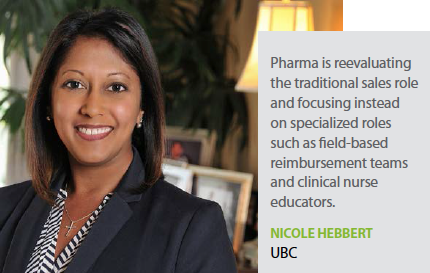 “Not only have their physician interactions expanded, but also their interactions internally with sales teams," he says. “MSLs are no longer strictly communicating science to key physicians but they are also now translating that science into relevant clinical practice and health economic decision making, tailored to specific audiences, regions, and patient segments. "
“Not only have their physician interactions expanded, but also their interactions internally with sales teams," he says. “MSLs are no longer strictly communicating science to key physicians but they are also now translating that science into relevant clinical practice and health economic decision making, tailored to specific audiences, regions, and patient segments. "
As a result, there is a broader definition of what constitutes a KOL. For example, key influencers today include local community leaders, patient advocacy groups, or HEOR, and actuary experts.
According to Mr. Sanchez, the role of the sales rep is diminishing in importance in specialty medicines, because at many of the top centers, reps may not even be allowed into the facilities. As a result, he says, KOL engagement has become crucial, as have top-down selling approaches that leverage market access to approach sales from a whole-system perspective.
Meeting the Challenge of Market Access
Companies are now thinking about access earlier in clinical development and designing studies to help provide evidence-based outcomes at launch rather than in response to postmarketing requirements, Ms. Hebbert says.
This means pharma is shifting marketing operating expenses away from meals and branded items left behind at physicians’ offices to data-driven research.
In addition, commercial teams are shifting responsibility to medical teams to help translate the unique science of various new therapies into relevant market positions to demonstrate their economic value to payers and physicians.
“Pharma has become increasingly familiar with FDAMA 114 and the types of data important to ensure a product’s access to marketplace," Ms. Hebbert says. “As payers have become increasingly more sophisticated in their controls and benefit designs, merging medicine and pharmacy management under one umbrella, pharma has had to reevaluate its approach."
As more companies get in to the specialty area, they struggle to manage a much more convoluted disbursement process and reimbursement cycles for expensive medications.
“Many companies are creating new roles within the organization; one major specialty pharma we work with, for example, now has reimbursement specialists who help doctors navigate the complexity of reimbursement," Mr. Groebel says.
Specialty companies are also focusing on patient advocacy more, implementing new systems to generate a better understanding of patients as well as new programs to help educate them on how to pay for a new drug, where to buy it, how to take it, and adherence. Many informed patients now actively reach out to the company directly with questions.
“It’s the evolution of pharma, especially as we move to personalized medicine," Mr. Groebel says. “There’s no more sampling out of the trunk any more." (PV)


















